Unveiling the Truth:
New Jersey Wildlife Myths and Facts
Dispelling popular myths, misconceptions, and fears
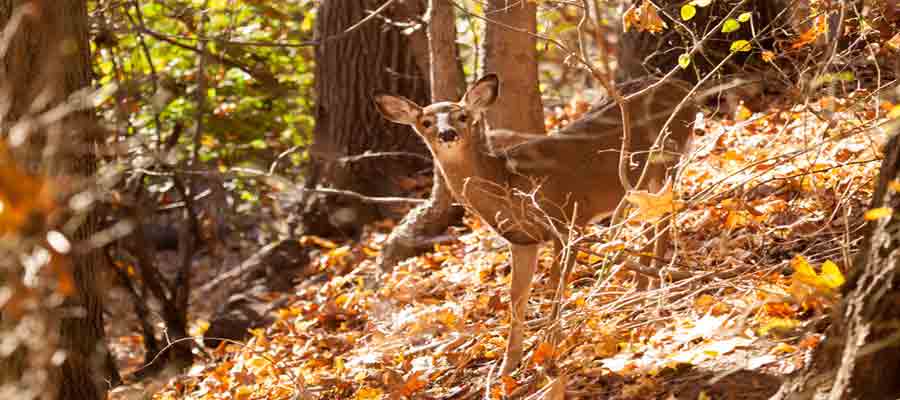
New Jersey may not be the first place people think of when it comes to wildlife, but the Garden State is home to a surprising variety of animals—and even more surprising are some of the myths and urban legends that surround them. Here are a few of the most popular myths about wildlife in New Jersey:
1. The Jersey Devil Is a Real Animal
The Myth: The Pine Barrens are haunted by the Jersey Devil, a winged, goat-like creature that screeches in the night and has terrorized locals for centuries.
Reality: While the legend dates back to the 1700s, there's no scientific evidence that such a creature exists. It’s more folklore than fauna, though it remains a beloved piece of NJ mythology.
2. There Are No Bears in New Jersey
The Myth: Many people are surprised to hear that black bears live in New Jersey, especially given how densely populated the state is.
Reality: Black bears are very real and quite common in the northwestern part of the state. Sightings have even occurred in suburban areas.
3. All Snakes in NJ Are Dangerous
The Myth: People often assume that every snake they see is venomous.
Reality: New Jersey is home to 22 species of snakes, but only two are venomous: the timber rattlesnake and the northern copperhead. Both are rare and tend to avoid humans.
4. Coyotes and Wolves Roam the Woods
The Myth: Some locals swear they've seen wolves or large packs of them in rural areas.
Reality: Wolves are not found in New Jersey. However, coyotes are, and their howls and size can easily be mistaken for something more dramatic.
5. Mountain Lions Live in NJ
The Myth: Occasional reports claim that mountain lions (also known as cougars or pumas) are stalking the woods of New Jersey.
Reality: The U.S. Fish and Wildlife Service considers mountain lions to be extirpated (locally extinct) in the East, except for the Florida panther. Most sightings are likely misidentified bobcats or large dogs.
6. Bats Will Attack You
The Myth: Bats are aggressive and will fly into your hair or attack people.
Reality: Bats in NJ are shy, beneficial creatures that help control insect populations. They want nothing to do with humans, though rabies concerns sometimes heighten fears.
7. Deer Are Harmless and Docile
The Myth: Many see deer as gentle creatures and don’t think of them as potentially dangerous.
Reality: While they aren’t aggressive, deer can cause serious car accidents, especially during mating season (rut). Bucks can also become aggressive if provoked.
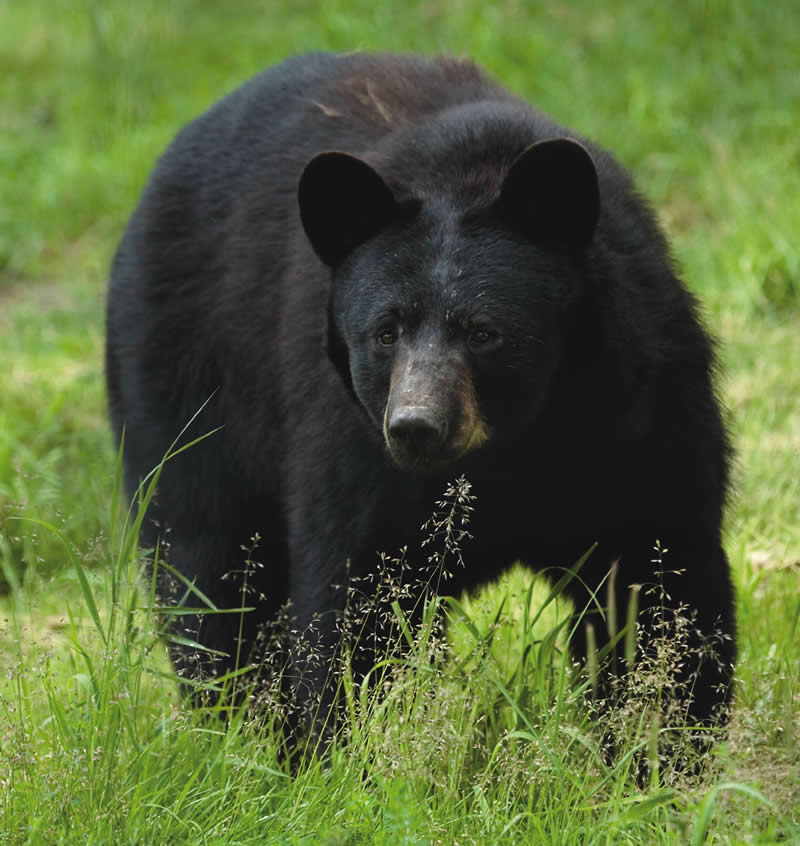
Photo Courtesy NJ DEP Division Fish & Wildlife
Black Bear
Black bears are the largest land mammal in New Jersey with adults weighing between 150–800 lbs and standing 5–7 feet tall on their hind legs.
The winter dormancy period begins in late October or early November, with some males not denning until December. Typical den sites include rock outcrops, brush piles, and large hollow trees; however, some bears may den beneath wooden decks or porches or simply at the base of a large tree. During this hibernation period, black bears enter a state of torpor, where their body temperature and respiration rate are reduced. A bear in torpor can wake, if disturbed, and bears may be active on warm winter days, searching for food.
Black bears serve an important role in healthy ecosystems. Considered an umbrella species, black bears use a variety of habitats during their life cycle. Their presence or absence in a region may be an indicator of the health and connectivity of an ecosystem. In addition, because they have the ability to travel great distances feeding on fruits and berries, bears disperse the seeds of many different plant species. When foraging, bears clear small amounts of vegetation, which opens up space for additional plants to grow. In this way, they promote biodiversity in several habitats.
They are an integral part of the state's natural heritage. Black bears are thriving and there are now confirmed bear sightings in all 21 of New Jersey's counties.
They are omnivorous and opportunistic feeders, eating mostly grass, berries and nuts. On occasion they eat fish and small mammals Black bears are solitary animals that roam large areas of land as a home base
Black Bear Myths and Misconceptions
Myth: Bears are dangerous predators.
Fact: Black bears are omnivores, meaning that they eat both plants and animals. Black bear attacks are extremely rare.
In most cases, bears will avoid direct confrontation with humans. First, remember that most black bears are not aggressive. When they encounter a human at close range, they often stand on their hind legs and swing their heads from side to side. This is not a sign of aggression, but rather a way of picking up a scent or focusing their weak vision. Do not run, avoid eye contact and sudden, jerky motions. Instead, speak calmly in low tones, and slowly back away. If it feels threatened, the bear may bluff charge, swat at the ground, or make huffing sounds, jaw pops, or grunts.
There has been only on case of fatal bear in New jersey On September, 2014, a fatal predatory black bear attack occurred in West Milford,NJ, resulting in the death of a 22-year old male. It is the first documented bear fatality in New Jersey's history.
Myth: Once a bear has tried human food, it won't eat wild food any more.
Fact: Bears naturally prefer wild food unless it is difficult to find and human food is too easy to get. Even the worst food conditioned bears still eat natural foods whenever they're plentiful. Conflicts usually increase when natural foods run out - a good time to be more vigilant of bear attractants on your property.
Sources:
NJ DEP Division of Fish & Wildlife
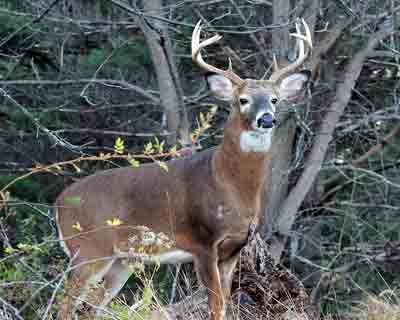
Photo Courtesy NJ DEP Division of Fish & Wildlife
White Tailed Deer
Deer are the largest wild herbivore in NJ.
As a result of the state’s deer management policies, the deer population in New Jersey is estimated to be about half what it was in 1995, down from 204,000 to about 101,000. 100 years ago, deer in NJ were "endangered."
There are no natural predators to deer in New Jersey in high enough numbers to affect the white-tailed deer population. Humans, motorists, and domestic dogs remain the only real predators.
Deer thrive in today’s environment because they are an edge species. This means they do not like large homogenous tracts of land, but land with borders and edge habitats. As the human population has increased and divided land, we have created a more suitable habitat for the white-tailed deer to not only survive, but actually thrive.
In suburban areas, deer often browse ornamental landscape plants, especially when competition for food is high. Deer are an “ecosystem engineer” species that, in conjunction with other species, appears capable of affecting the ecosystem at many levels and of degrading deciduous forests in New Jersey.
Deer populations have reached excessively high numbers in many areas of the state.
If deer were evenly distributed throughout the state, the 2013 population would average about 14 deer per square mile. For ideal bio-diversity the goal is a population below 10 deer per square mile
White Tailed Deer Myths and Misconceptions
Myth: There are more deer-car accidents during the hunting season because hunters scare deer onto the roads
Fact: Most deer-vehicle accidents happen after dark or before daybreak when there are no hunters out. Hunting season and the annual deer rut (mating season) coincide in late fall. During the rut, deer are energized by the mating instinct and often cross roads while pursuing does or being pursued by bucks.
The deer rutting season runs from late October through mid-December in all areas of the state, Also the shorter days during fall and winter mean that high traffic occurs at dawn and dusk when more deer are moving around.
Myth: Lyme disease spread by white footed mice, not deer.
Fact: Lyme disease is caused by a bacterium that is carried by the deer tick. While it is true that the bacteria is introduced into the tick by the white footed mouse, it is the white-tailed deer that is responsible for the increasing number of deer ticks. Without deer the tick cannot reproduce as it requires a large blood meal from a white tail deer. The deer is the host of choice for the adult tick. When deer numbers are reduced sufficiently, Lyme disease is reduced dramatically. Other animals do not substitute for the deer.
Sources:
NJ DEP Division of Fish & Wildlife
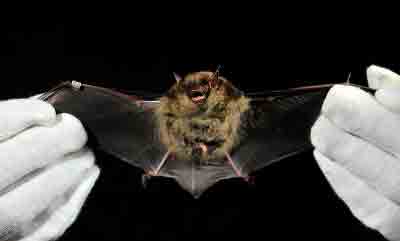
Photo Courtesy: Matt Rainey Rutgers New Jersey Agricultural Experiment Station
Bats
Despite their earned status as pests, the mammals are victims of many myths that perpetrate misconceptions about their treachery.
Bats are mammals possessing hair, giving birth to live young, and feeding young milk produced by mammary glands. Most produce only one offspring (called a pup) annually and rear their young for the first few weeks of life until they are able to fly and feed on their own. These reproductive and rearing practices make them the slowest reproducing mammals on earth for their size. Despite their slow reproduction, bats exist in large numbers and encompass one quarter of all mammal species, second in population only to rodents. Bats are the only true flying mammals and use echolocation to locate and acquire prey.
Bat species found in New Jersey are insectivorous and can consume thousands of insects in a single night.
Bats are actually quite harmless and are important indicators of a healthy environment. Since they are particularly vulnerable to pollution and pesticides, their presence or absence can tell scientists a lot about the overall health of the local environment.
Bats consume high volumes of insects each night and are the only major predators of nocturnal insects. Depending on the species, bats help remove a significant number of agricultural crop pests, reducing the need for chemical pest control. Bats provide many additional benefits to humans. For example, bat feces (guano) contain high concentrations of nitrogen and phosphorus and historically have been harvested for fertilizer.
It is illegal for anyone, including animal control officers and exterminators, to kill bats
Bat Myths and Misconceptions
Myth: Bats have a propensity for getting tangled in hair and thirst for blood.
Fact: Though bats do dive from the sky for insects, they almost never target humans or human hair
Myth: Bats are known to spread rabies
Fact: Like most mammals, bats can contract and transmit rabies, although less than one half of 1% of wild bats have rabies. In the past 50 years, only 48 U.S. residents are believed to have contracted rabies from bats. The fear of being infected with the disease by bats far exceeds the risks. Furthermore they will not encounter people by choice only in defense.
Source:
NJ DEP Division of Fish & Wildlife
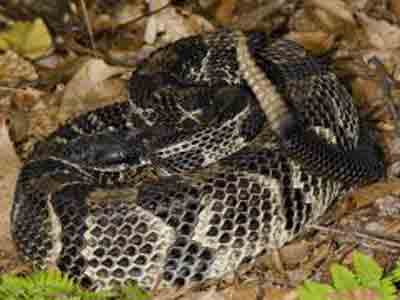
Timber Rattlesnake Photo Courtesy George Cevera: Conserve Wildlife Foundation of New Jersey
Snakes
There is perhaps no other animal victimized by myths, misconceptions, fear and contempt than snakes.
Snakes fill an important ecological role, controlling rodents and insects and serving as a food source for raccoons, bobcats, hawks, owls and other animals. In short, snakes are indicators of a healthy, vibrant ecosystem. Yet each year many snakes are intentionally killed by people who don’t understand them. While many killings occur out of fear, few people have ever been bitten by venomous snakes in New Jersey – and there is no record of anyone dying of being bitten by a venomous snake in the wild in New Jersey.
There are 22 species of snakes recognized in New Jersey. Of 22 species found in New Jersey, only the timber rattlesnake and the northern copperhead are venomous – and each of these species is generally shy.
Most of the species may look dangerous to humans, however, most are ultimately beneficial in the capture of rats and mice. Common non-venomous snake species include the Black Racer, Eastern Garter Snake, Milk Snake, Black Rat Snake, Eastern Ribbon Snake, Eastern Hognose Snake, Scarlet Kingsnake, and the Northern Water Snake which is commonly confused with the Copperhead. The Corn Snake is also present in New Jersey but it is an endangered species.
It is extremely rare for the average person to encounter a rattlesnake or copperhead due to their elusive nature, preference for interior forest habitat, small, localized populations, and sensitivity to human disturbance.
In New Jersey, copperheads are found only in the less populated northern portion of the state, from the Sourlands of Hunterdon, Mercer, and Somerset Counties in the south to the New Jersey/New York border in the north. They may also be found within the Palisades in Bergen County.
Tmber rattlesnakes are found in less populated, two separate regions of the state. In northern NJ they are found in the mountainous portions of Warren, Sussex, Passaic, Morris and Bergen counties. In southern NJ they are found in the southern Pinelands region and nearby portions of Cumberland, southern Ocean, Burlington and Atlantic counties.
The chance of being bitten by a venomous snake in New Jersey is far less than being struck by lightening. Those who have been bitten in the last half-century, in most cases have attempted to handle the snake, or more rarely, were walking through venomous snake territory in the dark with inappropriate footwear.
Under the state’s Endangered and Nongame Species Conservation Act, it is illegal to kill, harm, harass or collect any native, non-game wildlife. All relocations must be handled by professionals to ensure the snake’s survival.
If you suspect a snake on your property is a rattlesnake or a copperhead and is in need of relocation, call the DEP Endangered and Nongame Species Program’s northern region office at (908) 638-4381 or (908) 638-4127, or the southern region office at (609) 628-2103. After hours and on weekends call (877) WARN-DEP.
The Response Team will not relocate a non-venomous snake. Relocation disrupts the snake’s foraging-nesting cycles, and research shows that moving a snake too far from its natural habitat will kill it.
In relocating a venomous snake, the Response Team will look for suitable habitat in the same general area that won’t harm the snake or create a conflict with another property owner.
Snakes Myths and Misconceptions
Myth: Snakes are dangerous and harmful to people and the environment.
Fact: Snakes fill an important ecological role, controlling rodents and insects and serving as a food source for raccoons, bobcats, hawks, owls and other animals. Many snakes are intentionally killed by people who don’t understand them, Few people have ever been bitten by venomous snakes in New Jersey – and there is no record of anyone dying of being bitten by a venomous snake in the wild in New Jersey.
Myth: Beware of venomous water Moccasins swimming in NJ Lakes
Fact: Northern water snakes are frequently found swimming in waterways and basking on embankments, and are often mistaken for water moccasins, which do not occur in New Jersey.
Myth: Snakes are Aggressive and will attack people when approached.
Fact: Snakes do not chase people. Snakes prefer not to be around people. Snakes view people as predators and tend to escape when approached.
Sources:
New Jersey Chapter National Wildlife Control Operators Association
NJ DEP Division of Fish & Wildlife
Conserve Wildlife Foundation of New Jersey



